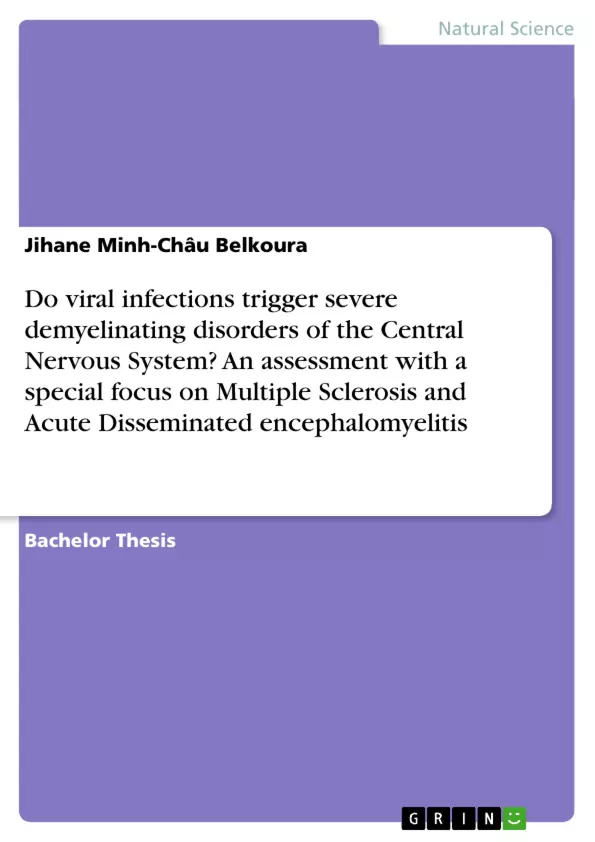Multiple Sclerosis (MS) is a progressive, disabling, neurological illness that
affects the brain and spinal cord. Nerve cells, which are usually surrounded by
oligodendrocyte myelin, are damaged, die and won’t be replaced when the
Central Nervous System (CNS) is inflamed. As a consequence, progressive loss of
the lipid rich myelin sheath surrounding axons result in disrupted, lower fidelity
action potentials and slow signal conduction. MS is thought to have a number of causes, however, none has been identified as the true causative agent. MS is the most common neurological disease in people below 30 and it affects more than 1 million young adults worldwide. It is five times more common in
temperate climates than in tropical areas and women are affected twice as often
as men are. Scientists suspect that MS develops because of the influence of genes
acting together. However, a common belief held by many scientists is that not
only the genetic influences, but also environmental influences, especially those of
viral infections, which trigger the disease.
This review considers the evidence in existence implicating viral responsibility in
the onset of myelination disorders.
Inhaltsverzeichnis (Table of Contents)
- 1. INTRODUCTION
- 1.1 MYELIN
- 1.2 CLINICAL ASPECTS
- 1.2.1 Multiple Sclerosis
- 1.2.2. Acute Disseminated Encephalomyelitis
- 2. THE PROCESS OF MYELINATION IN THE NERVOUS SYSTEM.
- 2.1. THE FOUR STAGES OF SCHWANN CELL DEVELOPMENT
- 2.1.2. The mature myelinating Schwann cell.
- 2.2. MYELINATION BY SCHWANN CELLS
- 2.3. FROM PRECURSOR CELL TO OLIGODENDROCYTE.
- 2.4. MYELINATION BY OLIGODENDROCYTES
- 2.4.1. Definition.
- 2.4.2. The process of myelination.
- 3. THE ACTION POTENTIAL
- 3.1. THE AXON
- 3.2. GENERATION OF AN ACTION POTENTIAL IN HEALTH
- 3.3. THE ROLE OF MYELIN IN THE CONDUCTION OF THE ACTION POTENTIAL
- 3.4. UNMYELINATED AXONS
- 3.5. THE GENERATION OF ACTION POTENTIAL IN DISEASE
- 4. MULTIPLE SCLEROSIS: WHAT WE KNOW.
- 4.1. A POSSIBLE MECHANISM OF THE AUTOIMMUNE REACTION
- 4.2. FACTORS INVOLVED IN THE DEVELOPMENT OF MS.
- 4.2.1. Genetic factors
- 4.2.3. Environment
- 5. IS MULTIPLE SCLEROSIS LINKED TO VIRAL INFECTION?
- 5.1. THE VIRAL PATHWAYS
- 5.1.1. Viral entry into the cell.
- 5.2.1. Viral entry into the CNS
- 5.2. THE MECHANISMS CAUSING DAMAGE
- 5.3. MS AND THE HUMAN HERPES VIRUS 6.
- 5.4. MS AND THE EPSTEIN-BARR VIRUS.
- 5.5. EVIDENCE FOR A VIRAL INDUCTION OF MS.
- 6. ACUTE DISSEMINATED ENCEPHALOMYELITIS: A DISEASE OF ITS OWN OR A VARIANT OF MS?
- 6.1. OLIGODENDROCYTE PATHOLOGY IN MYELINATION DISORDERS.
- 6.2. AXONAL DEATH
Zielsetzung und Themenschwerpunkte (Objectives and Key Themes)
This review explores the potential role of viral infections in the development of demyelinating disorders of the Central Nervous System (CNS), with a particular focus on Multiple Sclerosis (MS) and Acute Disseminated Encephalomyelitis (ADEM). The review examines the evidence for viral involvement in these diseases, the mechanisms by which viruses might trigger demyelination, and the specific viruses implicated in these disorders.
- The nature of myelin and its role in the nervous system
- The process of myelination in the nervous system
- The role of viral infections in demyelinating disorders
- The specific mechanisms by which viruses might trigger demyelination
- The evidence for a viral link in MS and ADEM
Zusammenfassung der Kapitel (Chapter Summaries)
The first chapter introduces the concept of myelin, its role in the nervous system, and the clinical manifestations of demyelinating disorders like MS and ADEM. Chapter two delves into the complex process of myelination, highlighting the involvement of Schwann cells and oligodendrocytes. Chapter three examines the action potential and how myelin facilitates efficient signal conduction. The fourth chapter discusses MS and the factors contributing to its development, including genetic predisposition and environmental influences. Chapter five delves into the potential role of viral infections in MS, exploring the mechanisms by which viruses might trigger the disease and specific viruses implicated in its pathogenesis. Finally, chapter six investigates ADEM, exploring its similarities and differences with MS and the pathological changes affecting oligodendrocytes in these conditions. The final chapter focuses on axonal death, a critical consequence of demyelination.
Schlüsselwörter (Keywords)
Demyelination, Multiple Sclerosis, Acute Disseminated Encephalomyelitis, viral infection, oligodendrocyte, myelin, action potential, pathogenesis, human herpes virus, Epstein-Barr virus, autoimmune reaction.
- Arbeit zitieren
- Jihane Minh-Châu Belkoura (Autor:in), 2004, Do viral infections trigger severe demyelinating disorders of the Central Nervous System? An assessment with a special focus on Multiple Sclerosis and Acute Disseminated encephalomyelitis, München, GRIN Verlag, https://www.hausarbeiten.de/document/27494


